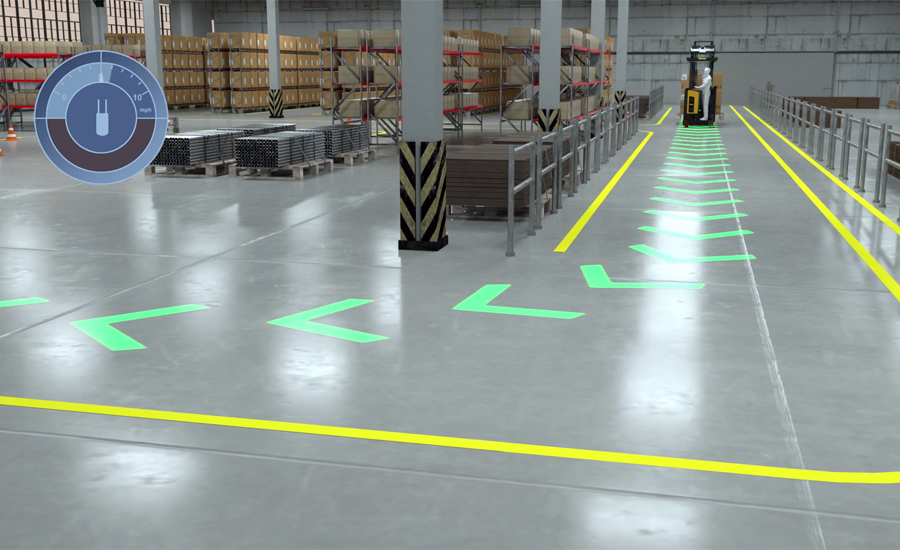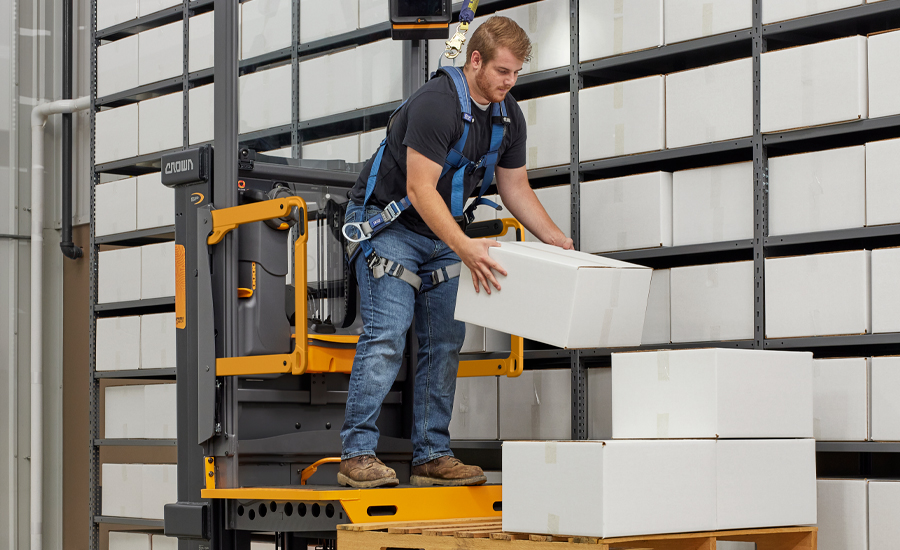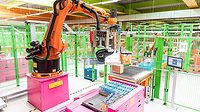Lift truck solutions work to transform warehouse operations
Safety, efficiency key to operational success in beverage warehouses

Image courtesy of Yale Lift Technologies
The phrase “pressure creates diamonds” is often used as a metaphor to convey the idea that difficult circumstances or “pressure” can lead to transformation, similar to how intense heat and pressure can transform carbon into the valuable gemstone of a diamond.
For beverage warehousing, although beverage trends such as SKU proliferation have put increased pressure on operations, experts note that advanced technology in lift trucks has worked to help transform warehouses.
“As consumers seek more variety, including specialty beverages, operations must store and move a larger selection of SKUs,” notes Kevin McWilliams, major accounts director at Yale Lift Truck Technologies, Greenville, N.C. “Expectations for that larger selection to be consistently in stock at brick-and-mortar stores in turn put greater pressure on delivery times, creating both a shift toward smaller, more frequent deliveries and a need for lift trucks capable of handling mixed loads while maintaining agility and efficiency.”
McWilliams further explains that lift trucks and associated technologies can help operations with greater efficiency in load handling and picking processes to get orders out the door on time.
“That’s especially true for lift trucks with productivity-enhancing designs that provide greater maneuverability or are powered by lithium-ion batteries with fast charging times and a long battery life,” he says. “And these trucks have use outside of warehouse applications — lithium-ion batteries powering pallet trucks in direct store delivery applications can charge anywhere, anytime through a standard 120V outlet, including on the back of a trailer between deliveries.
“Plus, lithium-ion batteries can help to reduce both emissions and spending — in the case of one customer, a shift to an all-electric lithium-ion lift truck fleet came with a 75% decrease in utility costs,” McWilliams continues.
Andy Jones, national account manager at Toyota Material Handling, Columbus, Ind., suggests that most beverage trends start with the bottler’s customer, such as grocery stores and gas stations.
“I like to say that the trend will start on the shelf and make its way back to the bottler. We see this all the time with packaging changes, just as an example,” he explains. “Ultimately, it’s always about finding ways to fit more product on the shelf in the same amount of space. These changes impact the size and weight of what is being delivered, which is ultimately a primary driver of changes in what kind of material handling equipment is needed.
“Companies in the beverage industry are constantly seeking the most effective delivery method for their product,” Jones continues. “The fewer times they have to touch the product, the better, so that’s where the versatility and durability of the Toyota product line really comes into play.”
Kaushik Ravichandran, product planning manager at Toyota Material Handling, adds that because of the steady pace of growth in the beverage industry, improving throughput has always been a key metric in operations.
“The need for increased throughput directly impacts the energy solutions used in forklifts,” he says. “To sustain heavy duty operations, choosing the correct battery solutions by performing a power study is critical to meet the operational requirements. At Toyota, we can help customers by conducting a power study, allowing them to specify the right lithium-ion battery solution for their unique application.”

Image courtesy of Yale Lift Technologies
Employee focused
Along with SKU proliferation, the growth of eCommerce has increased demands on beverage warehouses and distribution centers — elevating the value of skilled lift truck operators, experts note.
“Retaining these experienced operators continues to be important, especially since finding skilled replacements may be more challenging,” says Christopher Grote, senior project manager at Crown Equipment, New Bremen, Ohio.
“When it comes to hiring challenges and the use of forklifts in warehousing, many beverage warehouse managers are focused on creating a more operator-focused environment that places operator experience front and center,” Grote continues. “For instance, purchasing forklifts that are designed to make it easier for operators to work more comfortably, productively and safely throughout their shift.”
Yale’s McWilliams points to warehouse turnover, as well as employee safety as posing challenges to beverage operations.
“Warehouse turnover has hovered around 40% in recent years, and as operations deal with this challenge, they commonly depend on less-experienced employees or workers without substantial experience at a specific site,” he says. “Distracted or inexperienced lift truck operators may drive too fast, cut corners too sharply or even drive through prohibited areas, which can lead to mistakes, damage and injuries — more than 7,300 per year.
“In 2022, U.S. businesses spend a total of $167 billion on workplace injuries, according to the National Safety Council,” McWilliams continues. “As such, operations are turning to several solutions that can help mitigate the negative impacts of an inexperienced labor force. One of these solutions is automated lift trucks, which can follow site-specific rules of the road such as speed limits or minimum distance from pedestrians, helping to limit the potential for safety issues caused by inexperienced operators and protecting workers and productivity.”
As for safety measures in today’s forklift technology, McWilliams says that it’s essential that safety isn’t an outcome, but rather “a culture.”
“Safety is everyone’s job and must extend across operations and the supply chain. A culture of safety starts with instituting a strong operator training program,” he explains. “We offer a series of videos as part of the Yale Operator Training Program, which fulfills most truck-related topics in the formal instruction component of OSHA lift truck certification requirements. A series of equipment-specific orientation videos and virtual reality experiences are also available for training purposes, which can help give new operators a better sense of the truck they’ll be operating before actually getting in the operator compartment.”
Technology also can be leveraged to support safety in other ways, McWilliams says. For instance, the Yale Vision telemetry system makes critical maintenance data accessible while also providing alerts and fault codes related to hazardous driving behaviors, he notes.
“Access to this kind of data grants operations the ability to remediate problem areas and reinforce best practices,” McWilliams explains. “Advanced operator assistance technologies like Yale Reliant can also be used to help support operator awareness and adherence to lift truck operating best practices.
“If you’ve worked in a warehouse, you’ve likely experienced safety incidents such as an operator traveling too quickly through crowded areas or around turns, or a lift truck colliding with racking or other equipment,” he continues. “When operators slip up, a solution such as Yale Reliant steps in to help maintain lift truck stability.”
Crown Equipment’s Grote suggests that, given the nature of beverage warehousing, safety factors to consider lie in both the design and purchase of forklifts.
“Crown’s Intrinsic Stability System, which is found in the company’s electric counterbalance forklifts, uses integrated sensors and controllers to constantly monitor and control key forklift functions and movements to enhance stability and safety and give the operator an added level of confidence.
“Crown’s ProximityAssist feature uses light detection and ranging (LiDAR) to detect objects in the path of the vehicle,” Grote continues. “It alerts the operator and adjusts forklift performance to help promote safe, productive operations.”
Toyota Handling’s Jones notes that a top concern for beverage operations continues to be keeping pedestrians and forklifts separated as much as possible.
“The focus in each facility used to be aisles and guardrails,” Jones says. “Now, it’s moving toward things like geofencing for forklifts and pedestrian detection systems like Toyota’s Smart Environment Sensor Plus (SEnS+). These are great solutions where separating pedestrians and forklifts is not possible.”
Making a difference
Today, as beverage warehousing continues to contend with an abundance of challenges, experts highlight the impact software and other technological advancements are having on the newest lift trucks.
Yale’s McWilliams notes that new technologies are a key component for success in today’s global economy.
Under these pressures, operations recognize the importance of seamlessly integrated technologies as part of their lift truck solutions to help them prioritize safety, free up workers to tackle more fulfilling tasks and clear demanding productivity and sustainability targets.
“To put some numbers against that — an additional 5 billion square feet of warehouse space is needed to accommodate warehousing growth over the next few years, and each million square feet typically calls for 80 to 100 lift trucks to serve it,” he explains. “Under these pressures, operations recognize the importance of seamlessly integrated technologies as part of their lift truck solutions to help them prioritize safety, free up workers to tackle more fulfilling tasks and clear demanding productivity and sustainability targets.”
McWilliams gives the example of operator assist technology as a step warehouses can take today to not only alert operators of potential hazards but help avoid them.
“The award-winning Yale Reliant operator assist system keeps the operator in ultimate control of the lift truck, but automatically intervenes, proactively and carefully adjusting truck performance based on real-time conditions," he says. “For instance, it can reduce travel speed and smooth fork lift and tilt movement to help maintain truck and load stability, or limit travel speed, fork height and even zone access based on rules that warehouses can specify for certain areas in their facility.”
Crown Equipment’s Grote points out that today’s lift trucks have become more connected and intelligent.

Image courtesy of Crown Equipment
“[Technology] provides valuable data sets that can be used to make informed decisions about the size, use and productivity of the forklift fleet and address safety, training and operator performance concerns,” he explains. “Additionally, operator assist technologies can enhance productivity and the operator experience, enabling operators to achieve more.
“Forklift auto positioning technology interfaces with the warehouse management system to ensure that some VNA forklifts take the most effective route to the next rack location in high-reach applications,” Grote continues. “Auto height select enables operators to raise the forks to preprogrammed heights in high-reach applications with a press of a button. Object detection technologies use light detection and ranging (LiDAR) to detect objects in the path of the vehicle.”
Toyota Handling’s Jones notes that the largest software impacts are in the warehouse management system (WMS) space.
“The more efficiently the operator can do his or her job, the more quickly the product is on a truck and out the door,” Jones says. “Specifically for the beverage industry, automated case picking systems have become increasingly popular to help build unique pallets efficiently for the specific demands of the store where the product will be delivered. Shipping full pallets of the same SKU isn’t all that difficult. The challenge becomes when you are building pallets with several different SKUs. Automated case picking systems can help take the thinking out of the operator’s hands.”
As far as what ergonomic considerations to take into account when developing forklift solutions, Jones points to the benefits revolving around operator comfort in the areas of seats and hydraulics.
“A forklift is that employee’s office for the day, so a more comfortable seat and more user-friendly hydraulics — such as Toyota’s EZ Fingertip Controls — make a big difference over an eight to 10 hour shift. It’s all about developing solutions that make an operator’s life easier, which includes solutions that impact their line of sight such as swivel seats, pedestrian detection technology, or a rear assist grip.”
Yale’s McWilliams notes that the company’s lift trucks are engineered to deliver industry-leading ergonomics and key advantages in productivity.
“As part of our blueprinting process, we spend hours interviewing and observing lift truck operators and customers to enrich our understanding of how they use the truck and the realities of their applications,” McWilliams says. “Our engineers work with our industry-focused teams, such as those that specialize in beverage distribution warehouses, and outside experts to translate operator, customer and industry or application-specific needs to functional features and designs.
“From there, new products and technologies are rigorously rested and refined based on customer feedback,” he continues. “Some of the resulting ergonomic features on our top warehouse models include power-assisted automotive-style steering, generous space in operator compartments, cushioning that reduces shock and vibration and designs that help maximize visibility.”
Further, McWilliams points to the company’s integrated lithium-ion trucks — specifically designed to take advantage of the smaller shape and size of lithium-ion batteries — allowing for an open space design that gives operators greater freedom to position their feet.
“Each of these ergonomic features is designed with the aim of improving operator comfort and efficiency during their shifts, allowing warehouses to meet the demands of consumers and other businesses alike,” he concludes.
Looking for a reprint of this article?
From high-res PDFs to custom plaques, order your copy today!






